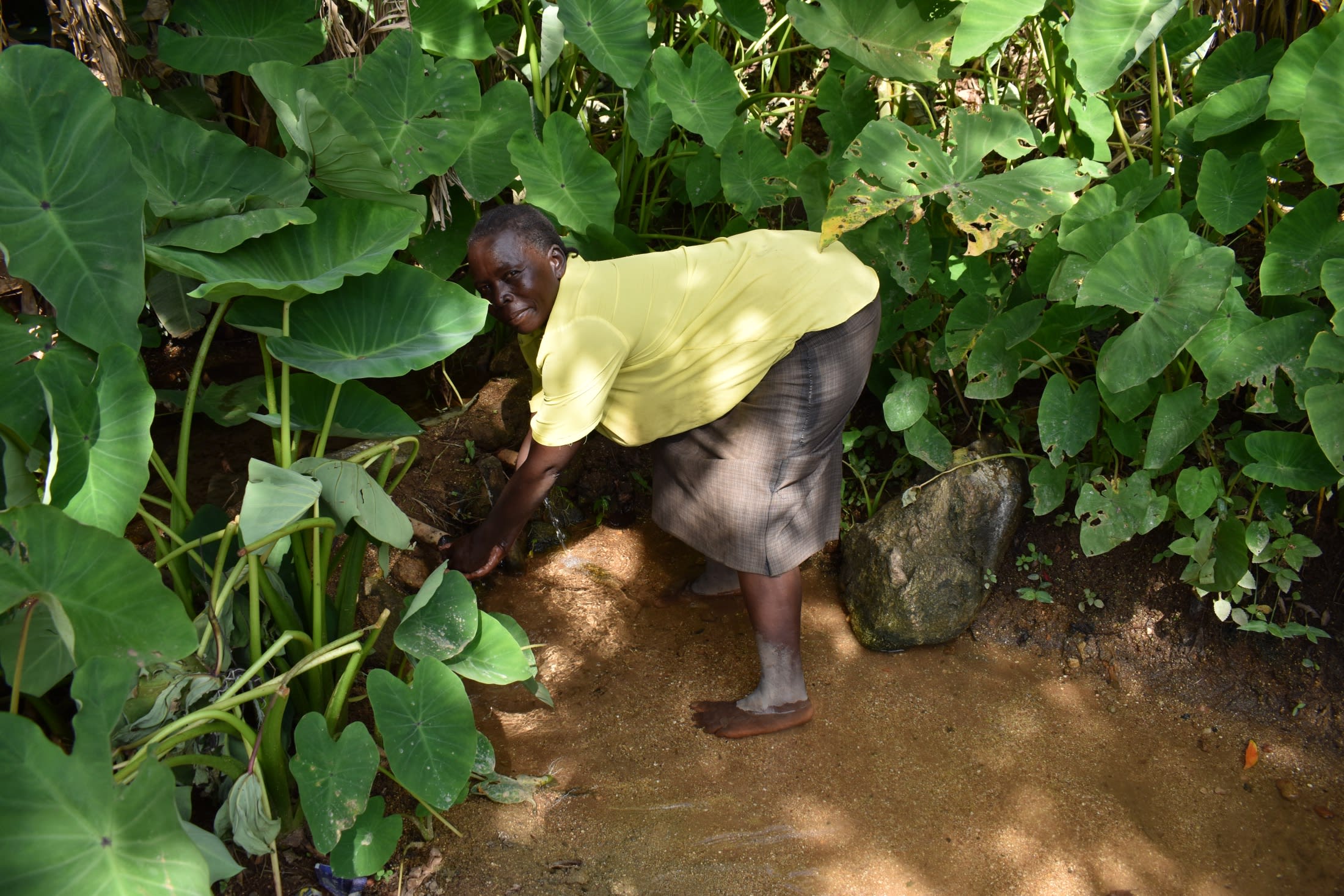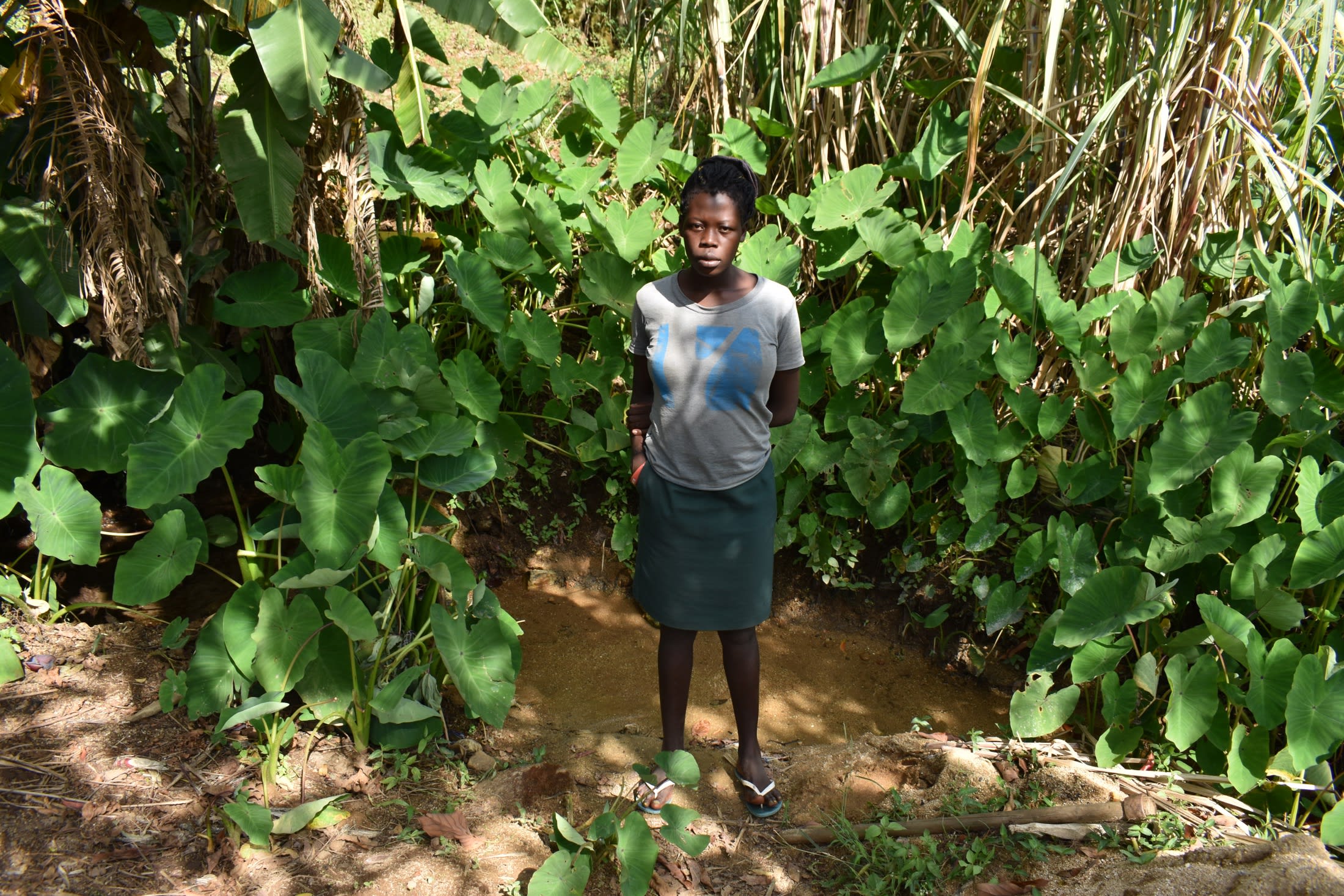February, 2023: Shimanyiro Community Spring Protection Complete!
Shimanyiro Community now has access to clean water! We transformed Akola Spring into a flowing source of naturally filtered water thanks to your donation. Our team also trained the community on improved sanitation and hygiene practices. Together, these components will unlock the opportunity for community members to live better, healthier lives.
"I have been fetching water full of mud at the spring," said 50-year-old farmer Helen Khadenje, whom we first spoke to on our first visit to Shimanyiro.

Hellen.
"[I] am grateful for this noble consideration for this community to benefit. Personally, [I] am sure of [drinking] clean water and improving my health. I have grandchildren here whom I have wished [could] access safe water. [I] am a proud grandmother knowing their health is good through access to clean water."
Children were just as excited as adults about the new waterpoint.
"The stormwater from this slope had been mixing up with this water, contaminating it," said ten-year-old Project B. "It has been my prayer always that one day we [would] get [an] improved water source. The access is now easier and will help me save time for other activities like washing, reading, and [preparing] early enough for church services."

Project carries water at the spring.
"Before the construction of this water point, we used to wash (bathe) here," Project continued. "[I] am going to teach others the importance of maintaining [the] water at [the] source to enable those downstream to access water with less or no contaminants caused through human activities, as taught by Teacher Milly."
By Teacher Milly, Project is referring to our field officer, Mildred, who facilitated the hygiene training.
Preparing for Spring Protection
Community members worked together to source and carry all locally available construction materials to the spring. These included bricks, sand, stones, and fencing poles. Some people also chiseled away at large rocks to break them down into gravel. Because people have to carry most items by hand, the material-collection process can take anywhere from a few weeks to months.

Hellen deposits stones at the construction site.
"The level of cooperation among the members of this group was so unmatched," said our field officer, Mildred. "It made the construction process short but fruitful because they availed themselves in large numbers to assist the assigned artisan."
When the community was ready, we sent a lorry to deliver the remaining construction materials, including cement, plastic tarps, and hardware. Then, our construction artisan and field officers deployed to the spring to begin work. Individual households provided meals throughout each day to sustain the work team.
From Open Source to Protected Spring: A Step-by-Step Process
First, we cleared and excavated the spring area. Next, we dug a drainage channel below the spring and several runoff diversion channels above and around the spring. These help to divert surface contaminants away.
To ensure community members could still access water throughout the construction process, we also dug temporary channels from the spring's eye around the construction site. This allowed water to flow without disrupting community members' tasks or the construction work. Excavation created space for setting the spring's foundation, made of thick plastic tarp, wire mesh, concrete, and waterproof cement.

The spring's foundation being laid.
After establishing the base, we started brickwork to build the headwall, wing walls, and stairs. Once the walls had grown tall enough, we began one of the most crucial steps: setting the discharge pipe. The discharge pipe needs to be positioned low enough in the headwall so the water level never rises above the spring's eye, yet high enough to allow room for the average jerrycan (a 20-liter container) to sit beneath the pipe without making contact.

Installing the discharge pipe.
If we place the discharge pipe too high above the spring's eye, backpressure could force water to emerge elsewhere. Too low, and community members would not be able to access the water easily. We embedded the pipe using clay (or mortar when clay is in short supply) and placed it at an incline to ensure water flows in the right direction.
In coordination with brickwork, we pitched stones on both sides of the spring's drainage channel. We then cemented and plastered each stone, forming the rub walls. These walls discourage people and animals from standing in that area, which could cause soil erosion and a clogged drainage area.

Adding stones to the rub walls.
We then cemented and plastered both sides of the headwall and wing walls. These finishing layers reinforce the brickwork and prevent water in the reservoir from seeping through the walls. In turn, enough pressure builds in the reservoir box to push water out through the discharge pipe.
As the headwall and wing walls cured, we cemented and plastered the stairs and installed four tiles beneath the discharge pipe. The tiles protect the concrete from the falling water's erosive force while beautifying the spring and facilitating easy cleaning of the spring floor.

Installing tiles.
The final stage of construction is backfilling the reservoir box behind the discharge pipe. We cleared the collection box of any debris that may have fallen during construction. Then we redirected the temporary diversion channels back into the reservoir box, channeling water into this area for the first time. We closed off all of the other exits to start forcing water through the discharge pipe only.

Backfilling the spring box.
We filled up the reservoir area with the large, clean stones community members had gathered, arranging them in layers like a well-fitting puzzle. We covered the rocks with a thick plastic tarp to minimize potential contamination sources, then piled enough dirt on top to compensate for future settling.
Community members transplanted grass onto the backfilled soil to help prevent erosion. Finally, the collection area was fenced to discourage any person or animal from walking on it. Compaction can lead to disturbances in the backfill layers and potentially compromise water quality.

Planting grass.
The entire construction process took about two weeks of work and patience to allow the cement and plaster to finish curing. As soon as the spring was ready, people got the okay from their local field officers to fetch water.
We officially handed over the spring to mark the community's ownership of the water point. Happiness, thanksgiving, and appreciation were the order of the day, flowing in all directions.
Field officer Mildred described the gathering: "After the successful completion of the project, the artisan in charge gave a remark, then handed over the program to the implementing officer, who thanked the community members for the high level of cooperation during the entire process, after which she granted Kefa Akolo, who is the chairperson, a chance [to speak]. He thanked the organization and the [the] donors at large for being kind and supportive to them. Finally, one church representative concluded the ceremony by offering a word of prayer, after which everyone was welcomed at the chairperson's home to have some lunch."
Training on Health, Hygiene, and More
Together with the community, we found their preferred date for training while considering other community calendar events, such as the agricultural season and social events. We requested a representative group of community members to attend training and relay the information learned to the rest of their family and friends.
When the day arrived, facilitators Mildred, Amos, and Godfrey deployed to the site to lead the event. 23 people attended the training, including 14 women and nine men.

Participants learn about the spring's construction and how to maintain it properly.
We covered several topics, including community participation in the project, leadership and governance, personal and environmental hygiene, water handling and treatment, spring maintenance, dental hygiene, the ten steps of handwashing, disease prevention, and how to make and use handwashing stations.
During the leadership and governance session, we held an election for the newly formed water user committee leaders, who will oversee the maintenance of the spring. We also brainstormed income-generating activities. Community members can now start a group savings account for any future minor repairs to the spring and a cooperative lending group, enabling them to develop small businesses.

Water filtration.
This group was eager to learn new ways of treating and handling water since water-related diseases had been such a huge problem in their community. We taught them a few methods on how to handle and store water while avoiding contamination, including filtering it through a clean cotton cloth and solar disinfection.
Everyone was also excited to learn the soap-making process, which they discovered was much easier than they thought it would be. Almost everyone at the training asked to take a turn adding ingredients or stirring the mixture.

Soap-making.
"Have you ever thought of a task being hard to perform, then realize later it's so easy to do?" asked one of the participants, while pointing to the finished soap.
"The training was so educative and helpful," said 15-year-old Valentine O., who already has a plan of how to spread the knowledge she learned.

Valentine, in the front left of this picture in the yellow shirt, celebrates with other community members at the spring.
"The training was educative in terms of the knowledge and skill of soap-making. Me being a leader and so close to my teachers, I will be able to have a discussion with [my] school principal and my chemistry teacher and my classmates on how we can purchase the soap reagents, prepare the soap, and be able to supply it to all the classes within the school to [be] used in cleaning purposes."

Valentine.
Valentine continued: "Secondly, [I] will have improved health due to the hygiene and sanitation practices discussed during the training: not forgetting to wash my hands, [brushing] my teeth in the recommended ways, and, at large, [maintaining] the highlighted hygiene and sanitation practices. [I] will also ensure I consume clean and safe water which has either been boiled, chlorinated, or solar-disinfected because demonstrations were done, and the consequences of not consuming the recommended water were also listed."
Conclusion
This project required a substantial collaboration between our staff, our in-country teams, and the community members themselves. When an issue arises concerning the spring, the water user committee is equipped with the necessary skills to rectify the problem and ensure the water point works appropriately. However, if the issue is beyond their capabilities, they can contact their local field officers to assist them.
Also, we will continue to offer them unmatchable support as a part of our monitoring and maintenance program. We walk with each community, problem-solving together when they face challenges with functionality, seasonality, or water quality. Together, all these components help us strive for enduring access to reliable, clean, and safe water for this community.
With your contribution, one more piece has been added to a large puzzle of water projects. In our target areas, we’re working toward complete coverage of reliable, maintained water sources within a 30-minute round trip for each community, household, school, and health center. With this in mind, search through our upcoming projects to see which community you can help next!
Thank you for making all of this possible!




 Protected Spring
Protected Spring
 Rehabilitation Project
Rehabilitation Project






































